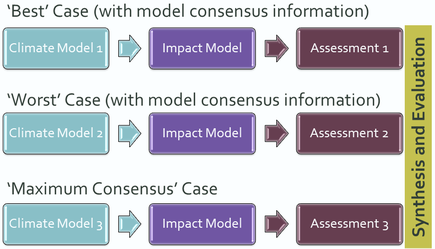Climate Change in Australia
Climate information, projections, tools and data

Explainer: Key steps in developing climate scenarios and identifying data sources
- Obtain/collate information on the sensitivity of the application to climate influences (e.g. crops are usually sensitive to rainfall, temperatures, evapotranspiration and solar radiation; particular seasons may be important); if necessary, do a simple sensitivity analysis.
- Determine the type of data needed (e.g. change factors, application-ready daily time-series).
- Define the key cases of interest, usually best case, worst case and maximum consensus. For example, a worst case for a cropping study is likely to be the hottest and driest future.

- Generate Climate Futures matrices for the region of interest for all relevant time periods and at least two emissions scenarios (VCP19 data are available for RCP4.5 and RCP8.5); populate the matrix with all variables (and seasons) to which the application is sensitive.
- Identify the key cases in each matrix.
- Identify representative models for each key case. (Check the information on model skill; reject any models that demonstrated poor performance in the region of interest.)
- In general, the VCP19 data should be used. However, if a key case climate future is populated by GCM data only, use the GCM data unless there is a compelling reason not to.
- Obtain the necessary data from the identified representative models.
- Complete an impact assessment separately for each case by using the data from the selected model (see figure). The results can then be synthesised and used to inform decision-making.
------------
Page updated 24th December 2020



